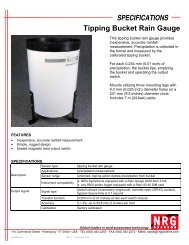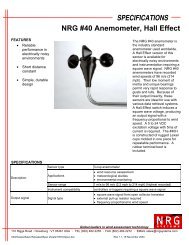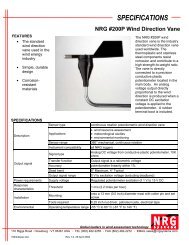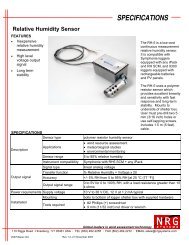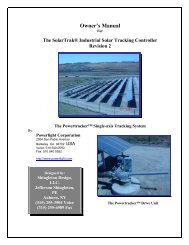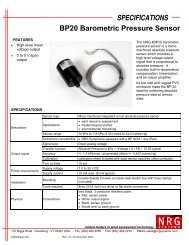Campbell Scientific CR-1000 Datalogger - Precision Solar ...
Campbell Scientific CR-1000 Datalogger - Precision Solar ...
Campbell Scientific CR-1000 Datalogger - Precision Solar ...
You also want an ePaper? Increase the reach of your titles
YUMPU automatically turns print PDFs into web optimized ePapers that Google loves.
<strong>CR</strong><strong>1000</strong> SpecificationsElectrical specifications are valid over a -25° to +50°C range unless otherwise specified; non-condensing environment required. To maintain electricalspecifications, <strong>Campbell</strong> <strong>Scientific</strong> recommends recalibrating dataloggers every two years. We recommend that the system configuration and criticalspecifications are confirmed with <strong>Campbell</strong> <strong>Scientific</strong> before purchase.PROGRAM EXECUTION RATE10 ms to 30 min. @ 10 ms incrementsANALOG INPUTS8 differential (DF) or 16 single-ended (SE) individuallyconfigured. Channel expansion provided by AM16/32Band AM25T multiplexers.RANGES and RESOLUTION: Basic resolution(Basic Res) is the A/D resolution of a singleconversion. Resolution of DF measurementswith input reversal is half the Basic Res.Input Referred Noise VoltageInput DF BasicRange (mV) 1 Res (µV) 2 Res (µV)±5000 667 1333±2500 333 667±250 33.3 66.7±25 3.33 6.7±7.5 1.0 2.0±2.5 0.33 0.671 Range overhead of ~9% exists on all ranges to guaranteethat full-scale values will not cause over-range.2 Resolution of DF measurements with input reversal.ACCURACY 3 :±(0.06% of reading + offset), 0° to 40°C±(0.12% of reading + offset), -25° to 50°C±(0.18% of reading + offset), -55° to 85°C (-XT only)3 The sensor and measurement noise are not included andthe offsets are the following:Offset for DF w/input reversal = 1.5·Basic Res + 1.0 µVOffset for DF w/o input reversal = 3·Basic Res + 2.0 µVOffset for SE = 3·Basic Res + 3.0 µVINPUT NOISE VOLTAGE: For DF measurementswith input reversal on ±2.5 mV input range; digitalresolution dominates for higher ranges.250 µs Integration: 0.34 µV RMS50/60 Hz Integration: 0.19 µV RMSMINIMUM TIME BETWEEN VOLTAGEMEASUREMENTS: Includes the measurement timeand conversion to engineering units. For voltagemeasurements, the <strong>CR</strong><strong>1000</strong> integrates the inputsignal for 0.25 ms or a full 16.66 ms or 20 ms linecycle for 50/60 Hz noise rejection. DF measurementswith input reversal incorporate two integrationswith reversed input polarities to reduce thermaloffset and common mode errors and therefore taketwice as long.250 µs Analog Integration: ~1 ms SE1/60 Hz Analog Integration: ~20 ms SE1/50 Hz Analog Integration: ~25 ms SEINPUT LIMITS: ±5 VDC COMMON MODE REJECTION: >100 dBNORMAL MODE REJECTION: 70 dB @ 60 Hzwhen using 60 Hz rejectionSUSTAINED INPUT VOLTAGE W/O DAMAGE:±16 Vdc max.INPUT CURRENT: ±1 nA typical, ±6 nA max.@ 50°C; ±90 nA @ 85°CINPUT RESISTANCE: 20 Gohms typicalACCURACY OF BUILT-IN REFERENCE JUNCTIONTHERMISTOR (for thermocouple measurements):±0.3°C, -25° to 50°C±0.8°C, -55° to 85°C (-XT only)ANALOG OUTPUTS3 switched voltage, active only during measurement,one at a time.RANGE AND RESOLUTION: Voltage outputs programmablebetween ±2.5 V with 0.67 mV resolution.ACCURACY: ±(0.06% of setting + 0.8 mV), 0° to 40°C±(0.12% of setting + 0.8 mV), -25° to 50°C±(0.18% of setting + 0.8 mV), -55° to 85°C (-XT only)CURRENT SOURCING/SINKING: ±25 mARESISTANCE MEASUREMENTSMEASUREMENT TYPES: The <strong>CR</strong><strong>1000</strong> providesratiometric measurements of 4- and 6-wire fullbridges, and 2-, 3-, and 4-wire half bridges.Precise, dual polarity excitation using any of the3 switched voltage excitations eliminates dc errors.RATIO ACCURACY 4 : Assuming excitation voltage ofat least <strong>1000</strong> mV, not including bridge resistor error.±(0.04% of voltage reading + offset)/V x4 The sensor and measurement noise are not included andthe offsets are the following:Offset for DF w/input reversal = 1.5·Basic Res + 1.0 µVOffset for DF w/o input reversal = 3·Basic Res + 2.0 µVOffset for SE = 3·Basic Res + 3.0 µVOffset values are reduced by a factor of 2 whenexcitation reversal is used.PERIOD AVERAGING MEASUREMENTSThe average period for a single cycle is determined bymeasuring the average duration of a specified numberof cycles. The period resolution is 192 ns divided bythe specified number of cycles to be measured; theperiod accuracy is ±(0.01% of reading + resolution).Any of the 16 SE analog inputs can be used for periodaveraging. Signal limiting are typically required for theSE analog channel.INPUT FREQUENCY RANGE:Input Signal (peak to peak) 5 Min. Max 6Range Min Max Pulse W. Freq.±2500 mV 500 mV 10 V 2.5 µs 200 kHz±250 mV 10 mV 2 V 10 µs 50 kHz±25 mV 5 mV 2 V 62 µs 8 kHz±2.5 mV 2 mV 2 V 100 µs 5 kHz5 The signal is centered at the datalogger ground.6 The maximum frequency = 1/(Twice Minimum Pulse Width)for 50% of duty cycle signals.PULSE COUNTERSTwo 24-bit inputs selectable for switch closure, highfrequencypulse, or low-level AC.MAXIMUM COUNTS PER SCAN: 16.7x10 6SWITCH CLOSURE MODE:Minimum Switch Closed Time: 5 msMinimum Switch Open Time: 6 msMax. Bounce Time: 1 ms open w/o being countedHIGH-FREQUENCY PULSE MODE:Maximum Input Frequency: 250 kHzMaximum Input Voltage: ±20 VVoltage Thresholds: Count upon transition frombelow 0.9 V to above 2.2 V after input filter with1.2 µs time constant.LOW-LEVEL AC MODE: Internal AC coupling removesAC offsets up to ±0.5 V.Input Hysteresis: 12 mV @ 1 HzMaximum ac Input Voltage: ±20 VMinimum ac Input Voltage:Sine wave (mV RMS) Range (Hz)20 1.0 to 20200 0.5 to 2002000 0.3 to 10,0005000 0.3 to 20,000DIGITAL I/O PORTS8 ports software selectable, as binary inputs or controloutputs. C1-C8 also provide edge timing, subroutineinterrupts/wake up, switch closure pulse counting, highfrequency pulse counting, asynchronous communications(UART), SDI-12 communications, and SDMcommunications.HIGH-FREQUENCY PULSE MAX: 400 kHzSWITCH CLOSURE FREQUENCY MAX: 150 HzOUTPUT VOLTAGES (no load): high 5.0 V ±0.1 V;low



